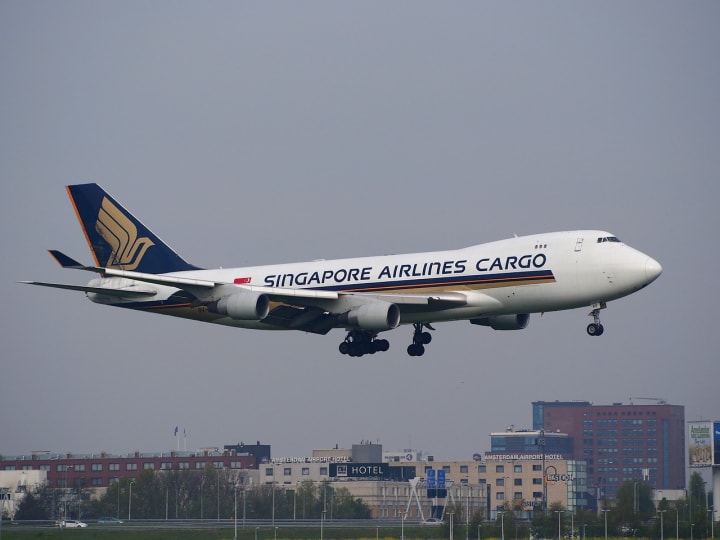How does a plane fly? Navigating the plane in the sky
Basic understanding of climbs, turns, descend, and landing a plane

Welcome aboard!
In the previous article, we covered the aircraft parts and discussed the basic principles behind takeoff and cruising during a flight.
In this article, we shall explore how a pilot navigates the plane in the sky and then safely brings the aircraft back to a safe landing.
This material is copyrighted by the author. Please do not republish, copy, or sell this material without exclusive permission from the author of this article. The images used in this article are sourced from the public domain. Links are provided at the end of this article.
Navigating the plane in the air
There are four phase of flight
- Cruise
- Turns
- Climbs
- Descent
Cruise flight
A cruise flight is one in which the plane maintains a constant altitude and airspeed while speeding through the air.
The cruise phase is usually between takeoff and landing, during which the plane maintains a constant altitude and airspeed while consuming the least amount of fuel.
Cruise flight is the most fuel-efficient phase of a flight, allowing the plane to achieve its maximum range.
Single engine planes can typically fly between 8,000 and 12,000 feet above sea level, while jet aircrafts can fly between 30,000 and 40,000 feet.
During cruise flight, pilots can relax, the crew can serve refreshments, and passengers can move around inside the plane.

Aircraft Parts
Before we begin learning about how a plane climbs, turns, and descends, let us look at the aircraft parts. (Refer figure)

Turning the plane
During cruise flight, the pilot can turn the plane by banking it to the right or the left, by adjusting the 'ailerons' on the wings.
When a pilot wants to turn a plane, they will move the yoke or the control wheel in the desired direction. The plane then turns by banking or tilting its wings downward in the direction of the turn.
The pilot also simultaneously adjusts the “rudder" and “elevator” controls on the tail, and the engine power to maintain a coordinated turn.

Turning the plane to the right
If a pilot wants to turn the plane to the right (Refer figure above), they will rotate the control wheel to the right.
This will cause the ailerons on the right wing to move up, and simultaneously, the ailerons in the left wing will move down.
As a result, right wing with the raised aileron will experience a decrease in lift, while the left wing with the lowered aileron will experience an increase in lift.
This difference in lift causes the plane to bank or tilt to the right.
While the pilot is turning the control wheel to the right, they also simultaneously apply the foot pressure on the rudder pedals to coordinate the turn and maintain the plane's heading.
The pilots may also adjust power to the engine to maintain a coordinated turn.
Once the desired turn is achieved, the pilot then levels the wings by moving the control wheel or the control stick back to the neutral position, and simultaneously remove the pressure off the rudder pedals and re-adjust the engine power.
Turning the plane to the left
Pilot can similarly turn the plane to the left by rotating the control wheel to the left, applying pressure to the rudder pedals, and adjusting engine power as necessary.
To turn left, the pilot applies a similar force on the aileron and the rudder controls in the opposite direction, and achieves a coordinated turn to the left.
Making the plane climb from a cruise flight
If the plane needs to climb from a cruise flight, based on our previous discussion we know that the lift must be greater than the weight, and this is achieved by:
- Increasing power by advancing the throttle, to increase the speed of the plane. This provides the additional lift required to climb the plane.
- The pilot also raises the nose of the plane by adjusting the pitch of the plane, by pulling back on the control yoke or stick to raise the elevator controls, and create more lift.
This will cause the plane to raise its nose and start climbing.
Once the desired altitude is reached, the pilot will level off the plane by reducing the engine power and simultaneously adjusting the pitch by pushing the control the wheel to maintain a steady altitude.
The pilot will then re-adjust the speed and other controls as necessary to maintain a steady cruise flight.
Making the plane descend from a cruise flight
If the plane needs to descend, then lift must be less than the weight, and this is done by lowering the nose of the plane and decreasing the power to the engine. To descend the plane,
- The pilot reduces the power to the engine which slows the plane down thus reducing the lift on the wings, and allowing the plane to descend.
- Simultaneously, the pilot also pushes on the control wheel to bring the nose down creating a pitch down attitude.
These two actions result in a decrease in lift and a change in the aircraft's attitude, facilitating the descent.
After descending to the desired altitude, the pilot will then level the nose by pulling the control wheel back to its neutral position.
The pilot also re-adjusts the power to the engine to maintain a steady cruise flight.
Landing a plane
When a pilot wants to land a plane at a designated airport from a cruise flight, a series of flight maneuvers are executed to bring the plane safely onto the runway.

- After the pilot has communicated with air traffic control and obtained clearance to land, the pilot enters a landing pattern, and then positions the aircraft on a coordinated approach to the runway.

- When the pilot needs to descend, they reduce the engine power.
- Reducing power to the engine slows down the plane, thus reducing the lift. This causes the plane to descend.
- The pilot also lower the nose of the airplane by adjusting the pitch of the plane through elevator controls. This controls the speed of the plane as it descends.

- The pilot continues the descent towards the runway, managing the engine power and adjusting the pitch to control the rate of descent.
- As the plane is descending, the pilot also extends the flaps and the landing gear. Pilots extends the flaps gradually to slow down the plane in a controlled manner.
- When the flaps are in the extended position, they increase the surface area of the wing. This helps to slow the aircraft down and create more lift.

- Flaps allow pilots to control the rate of descent and maintain a constant glide scope.
- Glide scope guides the pilots to maintain a steady rate of descent to reach the runway.
- The pilots can also reduce the engine power to idle, to decrease the speed further and reduce descent rate to allow the plane to land smoothly and safely on the runway.
- In a single-engine plane, as the aircraft approaches close to the runway, the pilot pulls back on the control yoke to raise the elevator controls. This rotates the plane from its nose down attitude to level attitude.
- As the plane levels off, the pilot further pulls back on the control yoke to raise the nose of the plane higher.
- This nose up attitude causes the plane to reduce its speed even further and increase its angle of attack.
- This reduces the lift to a bare minimum for the plane to nearly stall. In aviation, a stall is a situation where an aircraft's wings are not generating enough lift to sustain a continuous flight.
- The pilot maintains this control maneuver till the plane loses all of its lift force, finally causing the plane to touch down on its main wheels for a smooth landing.

In a single-engine plane, after touch down, the pilots holds the elevator till the front wheel touches down and slows the aircraft.
On a jet aircraft, once it touches down, the pilot deploys spoilers and reverse thrusters to slow down the aircraft and reduce its speed.
Finally, the pilot will taxi the aircraft off the runway and to a designated gate or a parking area.
To bring the plane to a complete stop, the pilot applies the brakes while keeping the throttle at idle speed, and then shuts off the engine.
Across all the phases of flight, landing a plane is one of the most challenging and complicated task.

Hooray! Great landing!
You have finally made it. Thank you for taking the time to read this article on how a plane flies.
I appreciate your interest and hope you found it informative. I hope that reading this article has inspired you to learn more about planes and consider taking flying lessons in the future.
If you have any questions or comments, please feel free to share them below.
References for pictures:
- Plane making an approach for landing https://www.pexels.com/photo/jet-cloud-landing-aircraft-46148/
- Jumbo Jet 747 North Cruise Sky https://pixabay.com/photos/plane-airplane-clouds-flight-3251802/
- Pilot turning control wheel to the right in a cockpit https://pixabay.com/photos/cockpit-dashboard-pilot-jet-6512964/
- Landing glide path https://pixabay.com/photos/plane-aircraft-landing-330487/
- Singapore Airlines 747 Cargo plane approach for landing https://pixabay.com/photos/boeing-747-jumbo-jet-867511/
- Plane approaches for landing https://pixabay.com/photos/airplane-flight-city-landing-river-3702676/
- Flaps extended for landing https://www.pexels.com/photo/photo-of-aircraft-wing-1928072/
- Singapore Airlines 747 Cargo plane touches down https://pixabay.com/photos/boeing-747-jumbo-jet-867523/
- Singapore 747 Cargo Taxing.jpeg https://pixabay.com/photos/boeing-747-jumbo-jet-867513/
About the Creator
Raghavendra S Rao
Passionate about life, people, animals, nature, and surroundings. Love flying airplanes. Educate everyone in various phases of life. Love technology. Learn new things. Help and contribute time and money to the less fortunate.






Comments
There are no comments for this story
Be the first to respond and start the conversation.